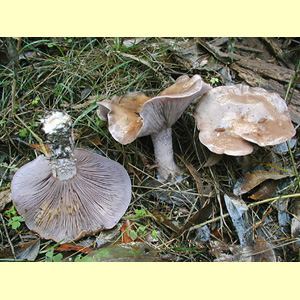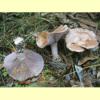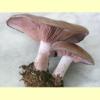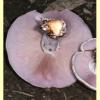
images/Lepista/Lepista.jpg
Medium to very large agaric, growing on the ground or rarely in association with vertebrate animal carcasses, with a cream to yellow, pale pink or pinkish brown spore print. Pileus pale, brown, purple or grey, viscid or not. Lamellae adnate, sinuate or notched or subdecurrent, rarely decurrent. Stipe central. Partial veil remnants absent. Spores hyaline, non-amyloid, warty; germ pore absent. Cheilocystidia absent. Lamellar trama regular. Pileipellis a cutis. Clamp connections present.
Among species with a pinkish brown spore print,
Lepista is very similar to larger species of
Clitopilus morphogroup Rhodocybe in the field, but the latter has spores that are angular in end view, and it generally lacks clamp connections. Species of
Lepista with a cream spore print (such as
L. flaccida) could be confused with
Clitocybe (which can have a cream spore print), but they differ by having ornamented spores. Other pale-spored agarics with ornamented spores often have amyloid ornamentation (as in
Lactarius,
Lentinellus,
Leucopaxillus,
Melanoleuca and
Russula). In
Hebeloma the spore print can be pinkish brown, but the pileus is usually viscid, and there are cheilocystidia.
Lepista (Fr.) W.G.Sm., J. Bot. 8: 248 (1870).
Six species:
Lepista endota,
L. flaccida (=
Clitocybe,
L. inversa,
L. gilva and
Clitocybe flaccida var.
lobata),
L. luscina,
L. nuda,
L. sordida and
L. sublilacina.
W.A., S.A., Qld, N.S.W., Vic. and Tas. (and probably also N.T.).
In native forests, and in parks and gardens.
On the ground. Occasionally associated with vertebrate animal remains.
Saprotrophic.
Breitenbach, J. & Kränzlin, F. (eds) (1991),
Fungi of Switzerland.
Volume 3. Boletes and Agarics 1st part. Edition Mykologia, Lucerne. [
Illustration,
Description and
Microcharacters of nine species from Europe including
L. flaccida (as
L. inversa),
L. luscina,
L. nuda and
L. sordida]
Fuhrer, B. (2005), A Field Guide to Australian Fungi. Bloomings Books, Hawthorn. [Description and Illustration of L. nuda]
Grey, P. & Grey, E. (2005), Fungi Down Under. Fungimap, South Yarra. [Description, Illustration and Map for L. nuda]
Grgurinovic, C.A. (1997a), Larger Fungi of South Australia. The Botanic Gardens of Adelaide and State Herbarium and The Flora and Fauna of South Australia Handbooks Committee, Adelaide. [Description and Microcharacters of L. nuda, L. sublilacina and L. endota, and Illustration of L. sublilacina]
McCann, I.R. (2003), Australian Fungi Illustrated. Macdown Productions, Vermont. [Illustration of L. nuda and several unnamed species]
Young, A.M. (2005b), A Field Guide to the Fungi of Australia. University of New South Wales Press, Sydney. [Description and B&W Illustration of L. nuda and L. sublilacina]




